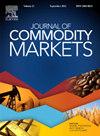对冲粮食价格风险。保持简单!粮食市场的计量经济学证据,1982-2024
IF 4.5
4区 经济学
Q1 BUSINESS, FINANCE
引用次数: 0
摘要
本文评估了7种对冲策略在降低美国粮食市场价格风险方面的有效性。这些策略包括naïve“一对一”对冲,以及误差修正模型(Error Correction models)和GARCH等先进的计量经济模型,这些模型允许时变波动。利用1982-2024年玉米、小麦和大豆的月度数据进行1997-2024年的样本外评估,我们评估了复杂模型是否比简单方法具有有意义的优势。我们发现,虽然所有策略都大大降低了风险,但在标准偏差、风险价值和预期不足方面,更简单的模型比更复杂的模型表现得更好。结果对不同的子样本和估计窗口保持鲁棒性。本文章由计算机程序翻译,如有差异,请以英文原文为准。
Hedging grain price risk. Keep it simple! Econometric evidence from the grain markets, 1982–2024
This paper evaluates the effectiveness of seven hedging strategies for reducing price risk in the U.S. grain market. The strategies are ranging from a naïve “one-for-one” hedge to advanced econometric models such as Error Correction Models and GARCH, allowing for time-varying volatility. Using monthly data for corn, wheat, and soybeans 1982–2024 for conducting out-of-sample evaluations 1997–2024, we assess whether complex models provide meaningful advantages over simpler approaches. We find that while all strategies substantially reduce risk, simpler models perform comparably to more sophisticated ones in terms of standard deviation, Value-at-Risk, and Expected Shortfall. The results remain robust to different sub-samples and estimation windows.
求助全文
通过发布文献求助,成功后即可免费获取论文全文。
去求助
来源期刊

Journal of Commodity Markets
Multiple-
CiteScore
5.70
自引率
2.40%
发文量
53
期刊介绍:
The purpose of the journal is also to stimulate international dialog among academics, industry participants, traders, investors, and policymakers with mutual interests in commodity markets. The mandate for the journal is to present ongoing work within commodity economics and finance. Topics can be related to financialization of commodity markets; pricing, hedging, and risk analysis of commodity derivatives; risk premia in commodity markets; real option analysis for commodity project investment and production; portfolio allocation including commodities; forecasting in commodity markets; corporate finance for commodity-exposed corporations; econometric/statistical analysis of commodity markets; organization of commodity markets; regulation of commodity markets; local and global commodity trading; and commodity supply chains. Commodity markets in this context are energy markets (including renewables), metal markets, mineral markets, agricultural markets, livestock and fish markets, markets for weather derivatives, emission markets, shipping markets, water, and related markets. This interdisciplinary and trans-disciplinary journal will cover all commodity markets and is thus relevant for a broad audience. Commodity markets are not only of academic interest but also highly relevant for many practitioners, including asset managers, industrial managers, investment bankers, risk managers, and also policymakers in governments, central banks, and supranational institutions.
 求助内容:
求助内容: 应助结果提醒方式:
应助结果提醒方式:


